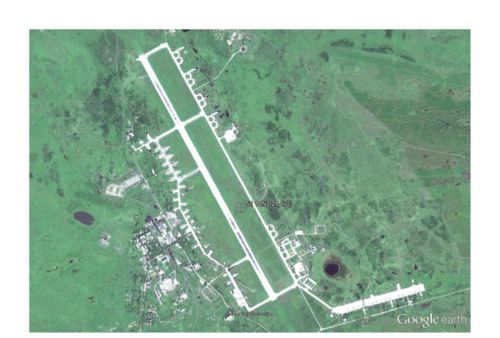
Long-Range Bombers at the Ukrainka Air Base in Russia’s Far East
51 10N 128 27E
The Obama administration is updating the guidance that will lead to the creation of a new U.S. nuclear war plan and determine the size and structure of U.S. nuclear forces. Here is the state of play.
Background and Status
In April 2010, the Obama administration completed its Nuclear Posture Review (NPR). Now, after numerous delays, it has begun the process that will implement the NPR’s decisions. This is being done via a two-part approach that is unlike the ones used by previous administrations. The first step has been described as developing the President’s “vision,” elaborating on the NPR. The second step is revising the employment policy for nuclear weapons (the war plans) and the force structure.
Step one formally began with new presidential guidance: Presidential Policy Directive 11 (PPD-11), which provided terms of reference for a Pentagon-led review that will provide options to President Obama based on the policies outlined in the NPR.
Initially, the review was supposed to be completed in the spring or summer of 2011, but that timeline slipped. In May 2011, the Pentagon’s Principal Deputy Under Secretary of Defense for Policy, Jim Miller, testifying before the Senate Armed Services Strategic Forces subcommittee, said this about the process: “We’ve had some initial discussions about both its content and the time line. We expect that when we do get presidential guidance to initiate the study, it will take several months.”
PPD-11 was finally issued this summer and work on the review formally began in early August. Described at one point by Miller as a 90-day “NPR Implementation Study,” a number of meetings were held in December to provide input to the administration’s FY2013 budget request. That request will be submitted in February, but decisions are generally made before the end of the calendar year.
The timeline for finishing the Pentagon-led study is now roughly similar to the budget time line. If things go as expected, the President should receive the study outcome later this month or in early February. Apparently, the analysis is completed, but has yet to be turned into a clear, defined set of options.
The Issues
The NPR has a number of areas where further elaboration is possible. For example, it says: “The United States will continue to strengthen conventional capabilities and reduce the role of nuclear weapons in deterring non-nuclear attacks, with the objective of making deterrence of nuclear attack on the United States or our allies and partners the sole purpose of U.S. nuclear weapons.” The study, one would imagine, could look at what steps would be required to meet that objective.
The study is also looking at possible additional reductions in U.S. nuclear forces, to serve as guidance for the desired next round of treaty negotiations with the Russians following up on New START. Officials have stated they would like those negotiations to include all nuclear weapons, meaning tactical and strategic, and deployed and non-deployed forces. The administration’s nominal deadline for an agreement with Russia is prior to the 2015 Nuclear Nonproliferation Treaty Review Conference, but given the rocky state of U.S.-Russian relations at present, all bets are off.
Another related question being considered is the future of the strategic triad. This or the next administration will face essential decisions about how and whether to replace each leg, starting first with SSBNs, then the bomber, and finally the ICMB leg. The recent budget debates have highlighted how expensive that proposition would be and some military commanders, including former Vice Chair of the Joint Chiefs of Staff Gen. James Cartwright, have stated that the United States cannot afford to replace the triad as it now exists.
The Process
The Pentagon-led review is being directed by the office of the Under Secretary of Defense for Policy, presumably with Jim Miller taking the lead. The process is similar to that for the NPR: an interagency team that includes the State Department, the White House’s National Security staff, the Department of Energy, and the Office of Science and Technology Policy in the White House and the military is developing options to present to the President. The Office of the Secretary of Defense, the Joint Staff (who serve the Joint Chiefs of Staff), U.S. Strategic Command, and the services are all participating for the military. However, in this case, the information is much more tightly held and fewer people are participating than was the case for the NPR. In addition, officials are unable to say publicly who exactly is participating in the process, but merely that an agency is represented.
Will the options given the President represent the “end to Cold War thinking” he has called for? The answer is unclear, but apparently some in uniform are resisting significant changes. Specifically, the new head of U.S. Strategic Command, Gen. Robert Kehler, seems inclined to a more cautious approach than his predecessor Gen. Cartwright has advocated.
Once the study is completed, the President will use it to develop and issue the second piece of presidential guidance, another PPD that provides overall, high-level direction to the military for the use of nuclear weapons. Through a long, involved process, that PPD will lead to a new target set, new detailed war plans, and revised required force levels. As Miller testified before the House in November, “This NPR implementation study will be followed by new presidential guidance and then in succession the Secretary of Defense and chairman of the Joint Chiefs will then issue more detailed planning guidance to the military, and then STRATCOM will revise its military plans.”
When pressed for more details on the process, including who was participating in the study, Miller deferred all additional questions to the White House.
The timeline for the process to complete the next round of guidance is unclear. Preparing the new PDD will presumably take some months, and turning that into a new war plan could take 18 months or longer.
According to officials, the second PPD will replace at least two Bush administration guidance documents, National Security Policy Directive 10 (NSPD #10) titled “U.S. Strategic Nuclear Forces,” and NSPD #14, “Nuclear Weapons Planning Guidance,” both from 2002. The former, done in tandem with the Bush Nuclear Posture Review, formally set the level of 1,700-2,200 deployed strategic nuclear forces announced by President Bush in November 2001 and later agreed upon by Russia in the “Moscow Treaty.” The latter formally led to the creation of the Bush administration’s new nuclear war plan, and it was on the basis of that plan and follow-on documents that the Obama administration set its positions for and negotiated the New START agreement.
Other Bush-era guidance could also be updated or replaced, including NSPD #28, “United States Nuclear Weapons Command and Control, Safety, and Security” from 2003 and NSPD #34, “Fiscal Year 2004-2012 Nuclear Weapons Stockpile Plan” from 2004. NSPD #28 focuses on ensuring U.S. nuclear weapons and warheads work only when authorized and not otherwise, and protecting critical information and information systems. One of the priorities for the 2010 NPR was to increase the President’s decision-making time, which will depend on robust command and control systems. NSPD #34 implemented the second round of reductions in the U.S. stockpile that the Bush administration publicly declared in June 2004, and reduced the total U.S. nuclear stockpile, including deployed and reserve forces, by “almost half.”
